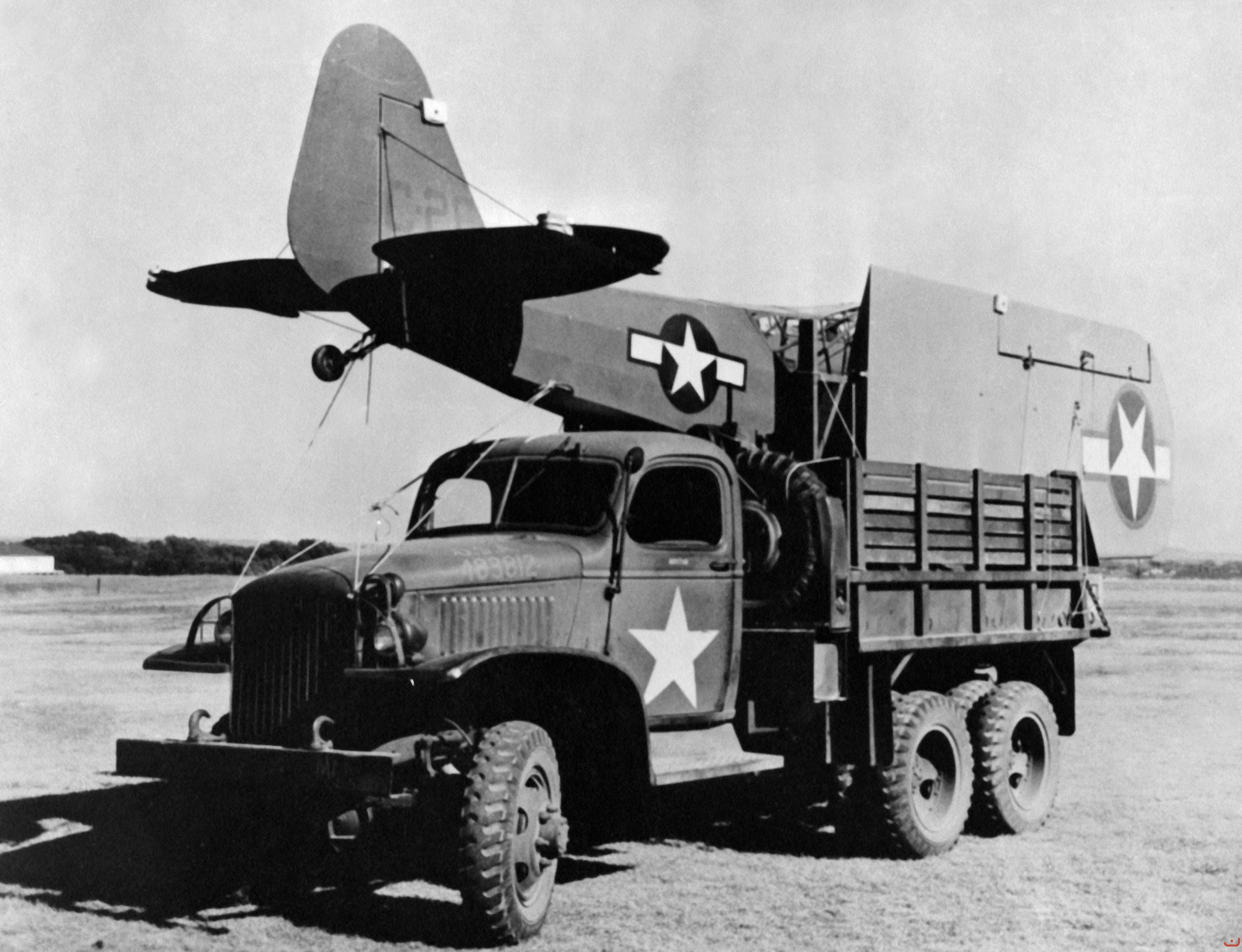
Looking Back / Army Aviation, June 2012; By Mark Albertson
For the 80th Anniversary of Army Aviation:
Class Before One, Part III
“Grasshoppers Prove Their Worth”
By Mark Albertson
 The versatility of the L-4 Cub is that it could operate on hard serviced runways, cow pastures and roads, as seen here during the 1941 maneuvers in Louisiana.
The versatility of the L-4 Cub is that it could operate on hard serviced runways, cow pastures and roads, as seen here during the 1941 maneuvers in Louisiana.
Ford’s squadron was slated to participate in exercises which would demonstrate the Air OP concept on an official basis, exercises which had been put on hold because of the Day of Infamy. These exercises were to be held at Fort Bragg, North Carolina and Fort Sam Houston, Texas from March 1 to April 16, 1942.
The recent graduates of the Class Before One, were to demonstrate their proficiency by the 1) adjustment of artillery fire, 2) general and road reconnaissance, 3) column control, 4) selection of battalion assembly areas, 5) identification of enemy batteries, 6) conducting prearranged fires, 7) surveillance of fire and 8) battery camouflage checks.[1]
The squadron was broken down into two flights: Flight A, commanded by 1st Lieutenant Edwin Hauser, with 11 planes and 13 officers and men, was to proceed to Fort Bragg, North Carolina for operations with the 13th Field Artillery Brigade. However a change of venue was ordered on March 24th, when the 13th Field Artillery Brigade was ordered to continue the maneuvers at Camp Blanding, Florida. This proved an advantage for Hauser’s flight, providing the opportunity for route column control during the period of transit, adding to the flight’s performance by such proficiencies displayed as operating off airstrips both paved and unpaved as well as country roads. The Cubs slalomed pylons like skiers and did power stalls over bamboo poles. They shuttled commanders from battlefront to battlefront; and most important, directed artillery fire.[2]

An attribute of the portability of the Cub was that Ground Forces transportation enabled the Army to shuttle its aerial assets.
Flight B, under the command of Major Gordon J. Wolf, proceeded to Fort Sam Houston, Texas for maneuvers with the 2nd Infantry Division. Wolf had 10 aircraft and 13 officers and men.
For flight B, competition in directing artillery fire would come from a contingent of Army Air Forces pilots and personnel. The Fort Sam Houston exercises were staged at the Leon Springs Military Reservation. This was where the 2nd Infantry Division practiced. So their observers were acquainted with the terrain. Flight B aviators were not. However, Ford’s boys caught a break. It appeared in the form of a questionnaire, directed to the boards from the Office of the Chief of the Field Artillery: Should artillery officers be required to train as observers? The board of the 2nd Infantry Division understood this to mean that observers could be recruited from artillery officer ranks within the division.[3]
Lieutenant Williams, operations officer for Flight B wasted little time. He contacted 1st Lieutenant Robert F. Cassidy, a West Point graduate who had washed out as a flier. But Cassidy had flown frequently as an observer for the Army Air Forces; and, he was extraordinarily familiar with the terrain at Leon Springs. And this helped to make the difference.[4]
Competition between AAF pilots and the Class Before One turned out to be no contest. AAF pilots took upwards of 30 minutes to adjust fire as opposed to ten minutes for Cub pilots and observers.[5] Lieutenant Cassidy, though, averaged just two minutes. For his superlative performance in rendering invaluable service to prove the Air OP concept, Cassidy was made an Honorary Member of the Class Before One.[6]
Another aspect of the exercises which cannot be overlooked was the light planes’ vulnerability to enemy fighters. In the case of Flight A at Camp Blanding, gun cameras on the P-39 Airacobra fighters recorded Cubs which were shot down. However anti-aircraft gun crews arrayed to protect the ground forces from air attack were equipped with cameras as well. Recorded, then, were Cub pilots hedge-hopping under the protection of gunners targeting enemy fighters seeking to bounce the flivver planes.[7]
Among the impressive outcomes of the tests in Florida and Texas was the apparent proficiency demonstrated by the Field Artillery personnel in operating their aircraft. Another was the ease and simplicity of the maintenance required to keep the light planes in the game. Another attractive attribute was how aircraft could be disassembled, loaded aboard 2.5 ton trucks and hauled to the next field of operations. The portability and mobility of the Army Aviation concept was at a decisive advantage and a definite contribution to the doctrine of Combined Arms Warfare. After all, in the end, this is what it was all about. The ability of a well-trained, well-equipped army to eat, sleep, move and fight as a well-organized team; something which would pay off for the United States Army by 1944-45. For Army Aviation, in the end, was a cog—one of vital importance, to be sure—but a cog in a panoply of components that were necessary for the success of a Combined Arms Warfare Team.
* * * * *
Grasshopper Test Group
Class Before One, Flight A, Assigned to the
13th F.A. Brigade, Ft. Bragg, N.C., and
Camp Blanding Fla.
| 1st Lt. F.A. Coune | Pilot-Mechanic |
| 2nd Lt. Lloyd M. Bornstein | Pilot-Mechanic |
| 2nd Lt. Charles W. Lefever | Pilot-Mechanic |
| 2nd Lt. Marion J. Fortner | Pilot-Mechanic |
| 2nd Lt. Delbert L. Bristol | Pilot-Mechanic |
| Staff Sgt. Joseph E. McDonald | Pilot-Mechanic |
| Staff Sgt. James W. Hill, Jr. | Pilot-Mechanic |
| Staff Sgt. Thomas M. Skelly | Pilot-Mechanic |
| Staff Sgt. Roland J. Couture | Pilot-Mechanic |
| Sgt. William T. Roulson, Jr. | Mechanic |
| Sgt. Walter J. Zimmerman | Mechanic |
| Sgt. Ralph E. Hage | Supply Sergeant |
Class Before One, Flight B, Assigned to the
2nd Infantry Division Artillery,
Fort Sam Houston, Texas
| Major Gordon J. Wolf, Flight Leader | Pilot-Mechanic |
| Captain Robert M. Leich | Engineer-Mechanic |
| 1st Lt. Robert R. Williams | Pilot-Mechanic |
| 1st Lt. Paget W. Thornton | Pilot-Mechanic |
| 1st Lt. John S. Sarko | Pilot-Mechanic |
| 2nd Lt. Steve E. Hatch | Pilot-Mechanic |
| 2nd Lt. Bryce Wilson | Pilot-Mechanic |
| Staff Sgt. Alwin R. Hackbarth | Pilot-Mechanic |
| Staff Sgt. Robert W. Donovan | Pilot-Mechanic |
| Staff Sgt. Robert W. Ford | Pilot-Mechanic |
| Staff Sgt. William R. Mathews, Jr. | Pilot-Mechanic |
| Staff Sgt. James T. Kerr, Jr. | Mechanic |
| Sgt. David S. Sweetser | Mechanic |
| Sgt. Walter T. Michalak | Mechanic |
Colonel William Wallace Ford, as overall commander, attended both maneuvers.
Source: See pages 162 and 163, Appendix B, “Grasshopper Test Group,” Wagon Soldier, by William Wallace Ford.
Endnotes
[1] See page 31, Chapter 2, “Background,” The Development of Organic Light Aviation in the Army Ground Forces in World War II, by Major Robert S. Brown.
[2] See page 22, “The Army Aviation Story,” Part I, United States Army Aviation Digest, by Richard K. Tierney.
[3] See page 72, Chapter 2, “The Field Artillery Acquires Its Own Aircraft, July 1941-June 1942,” Eyes of Artillery: The Origins of Modern U.S. Army Aviation in World War II, by Edgar F. Raines, Jr.
[4] See page 72, Edgar F. Raines, Jr.
[5] See page 32, Major Robert S. Brown, USA.
[6] See page 72, Edgar F. Raines, Jr.
[7] See pages 125 and 126, Chapter VIII, “Wings for Santa Barbara,” Wagon Soldier, by William Wallace Ford.
* * * * *
Update: Russo-Ukrainian War
Three months into the Russo-Ukrainian conflict and surprise abounds. For many the thought of Ukraine putting up such a spirited defense and Russia putting on such a lackluster military performance was as unforeseen as Superbowl III, when the upstart New York Jets defeated the heavily favored Baltimore Colts.
To begin with, the generally accepted figure of active Russian military personnel was some 900,000, 280,000 of which are ground troops. Reserves total some 2,000,000.[1] As of March 31, 2022, four weeks into operations, “NATO estimates that Russia lost between 7,000 and 15,000 soldiers. Wounded who cannot rapidly return to duty generally number about twice the number of dead. That would mean that Russia has lost between 21,000 and 45,000 troops in four weeks of conflict.”[2]
Mark F. Cancian compared these casualties with what the Soviet Army incurred in Afghanistan, in its war with the Mujahideen, from December 1979 to 1989. According to a study done by Lester W. Grau of the Foreign Military Studies Office at the Command and General Staff College at Fort Leavenworth, and Ali Ahmad Jalali, a military planner with the Mujahideen during the conflict, the Soviets lost 14,453 dead: 9,511 killed-in-action, with another 2,386 who died of wounds and 2556 others who succumbed to disease. Another 53,753 were wounded. But an astounding 415,932 were consigned to doctor’s care because of disease. These totals reflect on the sum of 620,000 soldiers consigned to service in Afghanistan for the war.[3] Officers put in tours of two years; enlisted men, eighteen months.
The war in Afghanistan was more of a counterinsurgency; as opposed to the Ukrainian model which is emblematic of a conventional-style of conflict. But what is fascinating is the attrition of Russian general officers or, the professed attrition of same, within the present fog of war.
Russian General Officers Killed (or professed to be killed)
Source material “Russian General Officer Guide, by Mason Clark, Karolina Hird and Kateryna Stepanenko, Institute for the Study of War, May 11, 2022.
Lieutenant General Yakov Vladimirovich Rezantsev, Commander, 49th Combined Arms Army. Ukrainian forces claimed to have killed Rezantsev at the Chornobaivka aerodrome, Kherson Oblast, March 24.
Lieutenant General Andrey Nikolayevich Mordichev, Commander, 8th Combined Arms Army. According to Ukrainian Military Intelligence, Mordichev was in command, at one point, of the attack on Mariupol. He was supposed to have been killed in action on March 18; yet, he was later seen in a video with Ramzan Kadyrov, the leader of Chechnya. It is reputed, though, that the video had been released as undated.
Major General Vladimir Petrovich Frolov, Deputy Commander, 8th Combined Arms Army. Frolov was reputed to have been killed during the Russian invasion of Ukraine; though he was buried with military honors on April 16, 2022.
Captain of the First Rank, Andrey Nikolayevich Paly, Deputy Commander, Russian Black Sea Fleet. Paly was supposed to have been killed in Mariupol during a Ukrainian shelling, March 20. Kremlin media sources confirmed his death.
Major General Andrey Borisovich Kolesnikov, Commander, 29th Combined Arms Army. Kolesnikov assumed command of the 29th CAA on December 7, 2021. He is supposed to have been killed in Ukraine on March 11, 2022.
Major General Vitaly Petrovich Gerasimov (no relation to the Chief of the General Staff, Army General Valery Vasilyevich Gerasimov), Chief of Staff, 41st Combined Arms Army. He was reported killed by Ukrainian forces on March 7, during actions near Kharkiv.
Major General Andrey Alexandrovich Suovetskiy , Deputy Commander, 41st Combined Arms Army. Suovetskiy was reported killed on March 3, by Russian sources.
Russian Commanders Removed
Admiral Igor Vladimirovich Osipov, Commander-in-Chief, Black Sea Fleet. Osipov was accorded the rank of Admiral in 2021 by presidential decree. He was given command of the Black Sea Fleet in October the same year. But according to Ukrainian Military Intelligence, Osipov was removed from command over the loss of the Moskva. Though at the time of this writing, the Institute for the Study of War cannot verify this claim.
Lieutenant General Sergey Alexandrovich Kisel, Commander, 1st Guards Tank Army. According to Ukrainian Military Intelligence, Kisel was removed from command and consigned to house arrest for “indecisiveness and cowardliness” when in command of troops in the Sumy and Kharkiv Oblasts. Of course, needs to be verified.
Lieutenant General Vladislav Nikolyevich Yershov, Commander, 6th Combined Arms Army. On April 22, Ukrainian Military Intelligence reported that Yershov had been removed from command. Earlier it had been reported that he was removed and placed in house arrest for excessive losses of troops during the invasion of Ukraine.
Lieutenant General Mikhail Stepanovich Zusko, Commander, 58th Combined Arms Army. Zusko assumed command of the 58th CAA in August 2020. He was another commander reputed to have been removed due to combat losses incurred by the 58th CAA in Ukraine. Zusko was to have been removed on March 31.
The Institute for the Study of War reminds the reader that this study, from which the above roster of deaths and removals of Russian military general officers is made available, is “for the military, government and other researchers.” Despite the fact it is a source worth referring to since it showcases the Russian Military Officer Class, it is going to be revised and updated with fresh data as the conflict proceeds.
Yet when there is smoke there is sometimes a fire. The Russian military has put in a less than stellar performance against its underrated Ukrainian opponent. Recall, Stalin, during the decisive land campaign on the Eastern Front, 1941-1945, when he had some 247 generals and admirals shot for “incompetence, cowardliness and other inefficiencies.” Hitler removed more than 30 commanders after the first year’s campaigning on the Russian Front in 1941, including the armored theorist, General Heinz Guderian. The Shia Fundamentalist regime of Ayatollah Khomeini had many commanders from the Shah’s military high command liquidated. This, of course, will adversely affect the performance of the Iranian armed forces when invaded by Iraq in September 1980. Indeed, do not conform to the expectations of a dictatorial regime and removal or even “termination of your services” could be your lot.
Another service rendered in the Russian General Officer Guide was an understanding of the Russian general ranks, as follows:
Marshall of the Russian Federation. Generally seen as the equivalent of a Five-Star General in the United States Army. At this juncture, no one in Putin’s Russia holds such a position. Indeed, only one officer has held such a ranking in the post-Soviet era, Minister of Defense, Igor Sergeyev, from 1997 through 2006. One much entertain the fact that Vladimir Putin may view such a position as a political threat. Note the position of the Egyptian officer class, rising with Nasser in 1952, with the Free Officers Movement. The German High Command perpetuated the Silent Coup on August 29, 1916, consigning Kaiser Wilhelm II to his estate to saw the wood and tend the garden. The many Founders of the American Republic had a distinct distrust of a large regular military; and, in particular, an Officer Class, owing to the potential machinations of some of the Continental Army officers during the Newburgh Incident, March 15, 1783. For as George Washington observed in his Farewell Address as the Republic’s first President, “. . . avoid the necessity of those overgrown Military establishments, which under any form of Government are inauspicious to liberty, and which are to be regarded as particularly hostile to Republican Liberty.”[4]
Army General/General of the Army. Considered the equivalent of a Four-Star General in the United States. Defense Minister Sergei Shoigu and Chief of the General Staff Valeri Gerasimov hold this rank; as do Army General Aleksandr Vladimirovich Dvornikov of the Southern Military District and Russian Aerospace Forces commander, Army General Sergei Vladimirovich Surovikin. Note, here, Surovikin, who is still billed as an “Army” General despite commanding the Aerospace Forces.
Colonel General. On par with the three-star or lieutenant general in the United States. Generally, Military District commanders are holders of this rank.
Lieutenant General. Equivalent of the two-star or major general in the United States. These are generally army commanders and chiefs of staff.
Major General. American equivalent is the one-star or brigadier general. Generally division commanders and army chiefs of staff hold this rank.
Endnotes
[1] According to the Congressional Research Service, Russian ground forces amount to 280,000. Airborne personnel amount to 45,000 with Spetnaz types upwards of 20,000 men. The balance of the active forces are spread among the Navy, Aerospace Forces and Strategic Rocket Forces. Based on IISS Military Balance 2020, Jane’s Sentinel Security Assessment. Crsreports.congress.gov/product/pdf/lf11603
[2] See page 1, “Russian Casualties in Ukraine: Reaching the Tipping Point,” Center for Strategic International Studies, March 31, 2022, by Mark F. Cancian, Senior Advisor, International Study Program.
[3] See page 2, “The Soviet-Afghan War: Breaking the Hammer & Sickle,” by Lester W. Grau and Ali Ahmad Jalali, VFW Magazine, January 2002.
[4] See page 967, “Farewell Address, 1796,” George Washington, Writings, The Library of America. Literary Classics of the United States, Inc., New York, NY., 1997.
























